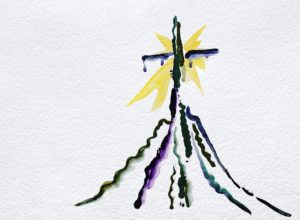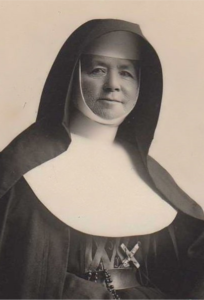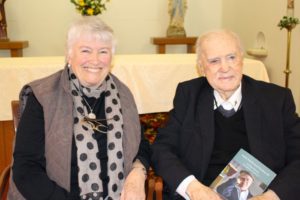Turn Again
February 26, 2020Elaine Wainwright* offers an ecological reading of the Ash Wednesday readings Joel 2:12-18 and Matthew 6:1-6; 16-18.
 Ash Wednesday is at the end of February (26th) and begins the season of Lent. The readings for this day are characterised by a call to conversion and this theme weaves through the six weeks of Lent. I have chosen the first reading Joel 2:12-18 and the Gospel Matthew 6:1-6,16-18 to begin our year of ecological readings of lectionary texts.
Ash Wednesday is at the end of February (26th) and begins the season of Lent. The readings for this day are characterised by a call to conversion and this theme weaves through the six weeks of Lent. I have chosen the first reading Joel 2:12-18 and the Gospel Matthew 6:1-6,16-18 to begin our year of ecological readings of lectionary texts.
Reading biblical texts ecologically is an approach that is informed by the ecological consciousness emerging among many people in our world. It is about paying attention to the whole Earth community — the human characters and their relationships as well as the other-than-human, such as the land and animals, and to the presence or absence of right relations among these. It is a “critical” approach like other ethical approaches to reading the Scriptures such as feminist and postcolonial interpretations. The significant difference characterising an ecological approach is that the other-than-human relationships are often not explicit in the text — they’re encoded…
Continue reading the article below:
Tui Motu Issue 245, February 2020 (PDF)
Ash Wednesday 2020
Ash Wednesday falls on 26 February this year.
Just listening to these words must surely give us hope. It is a time for us to look within ourselves to see if we are taking the right direction in our lives and to understand the movements of the heart. Are we more motivated by self or by our love of God?
 We cannot go on doing the things we used to – the very ground is shifting under our feet. Are we ready to tread new ground and make those necessary changes to create something new? Change is not just a climatic incident but can appear overnight if we let it. Change is relative to time; it is for those who desire improvement in their lives. No change can take place unless you allow it.
We cannot go on doing the things we used to – the very ground is shifting under our feet. Are we ready to tread new ground and make those necessary changes to create something new? Change is not just a climatic incident but can appear overnight if we let it. Change is relative to time; it is for those who desire improvement in their lives. No change can take place unless you allow it.
As we manoeuvre this winding path, we are called to make decisions that could affect our whole lives and the lives of those around us. Reflecting and spending time in prayer during Lent helps us acknowledge who we are in relation to God and offers us the opportunity to change. We are called to leave our old ways and follow Jesus, trusting in Him, as the disciples did. We cannot tread a new path without letting go of the old, and so we must be prepared to let go of anything that gets in the way.
Ash Wednesday marks the beginning of our journey through the Passion and Resurrection of Jesus to bring about this change, moving away from our normal way of life and making a new start to share in the glory of Easter.
A change of heart can make all the difference!
Cyrilla Almeida
Footnote:
[1] Pope Francis, 5 March 2014
Te Kiritahitanga/Fusion Still Growing
February 22, 2020On 22 February 2013, a document was signed in Rome by Cardinal Joao Braz de Aviz authorising the fusion of the Sisters of St Joseph of Nazareth, Whanganui with the Sisters of Saint Joseph of the Sacred Heart.
 The communication was received by Sr Anne Derwin, Congregational Leader of the Sisters of Saint Joseph of the Sacred Heart on 11 March 2013. Sr Anne immediately contacted Whanganui, where the news was joyfully received as a culmination of several years of discernment and discussion.
The communication was received by Sr Anne Derwin, Congregational Leader of the Sisters of Saint Joseph of the Sacred Heart on 11 March 2013. Sr Anne immediately contacted Whanganui, where the news was joyfully received as a culmination of several years of discernment and discussion.
It was 24 August 2013, when Te Kiritahitanga/Fusion was formally celebrated in Whanganui. In St Mary’s Parish Church, Sisters from across New Zealand and Australia gathered for a Eucharist of Thanksgiving for the reunification of the Sisters founded in 1866 by Julian Tenison Woods and Mary MacKillop. The original charism taken up so readily by the first Sisters, had stayed alive despite separation, misunderstanding and lack of contact over the years.
The later years had led to more interaction between the separated groups – the sharing of resources, combined gatherings and personal friendships. So the celebration in Whanganui that day was full of hopes and expectations. From the joyful greetings as Sisters gathered for the Eucharist to the beauty of their participation together in the celebration, all were high in expectations for the future.
So now, as we look at Fusion from the perspective of 2020, how has it been? Each Sister no doubt will have her own perceptions, opinions and experiences. As personal interactions and friendships have developed or grown, we have discovered much about each other, as in a family that has been separated. We have gathered for contemplative sharing, for discussions and for celebrations. We have realised that there are differences in our former ways of formation, of leadership models, of governance. The smaller groups numerically can often feel ‘swallowed up’ by the larger group. Yet these are signs of the rich diversity that we bring to each other and from which we can grow. All can be gift if we but allow it.
At the celebration of Te Kiritahitanga/Fusion on 24 August 2013, Sr Anne Derwin spoke of our two groups “returning to the oneness of our founding, being reconcilers of history, honouring the movement of the Spirit towards unity, and combining our strengths for the mission of God”.
Our recent Congregational Chapter calls us to be ‘audacious women’ moving into the next decade. And this coming decade certainly promises to be challenging on so many fronts on our planet Earth.
We Josephites will need that audacity to continue the fusing of our gifts as we move forward to genuine Kiritahitanga – that is ‘being of one skin’, discerning for today what the founding vision calls us to be for our world.
Anne Burke rsj
New Co-ordinator for Mary MacKillop Penola Centre
February 14, 2020 For some time, the winds of change have been blowing around the Mary MacKillop Penola Centre.
For some time, the winds of change have been blowing around the Mary MacKillop Penola Centre.
Changes are afoot with the appointment of a new co-ordinator following the retirement of Mrs Claire Larkin in September, 2018. Sisters of Saint Joseph, Loreto O’Connor and Sue McGuinness, took on this role in a care-taking capacity as acting co-ordinators until a new appointment was made.
Marie Valenzuela took up her position in a part-time capacity on 10 February, 2020. The position is generously supported by the Archdiocese of Adelaide. This financial support emphasises the importance the Archdiocese places on Saint Mary of the Cross MacKillop in the life of the Church and the significance of Penola as a sacred place of pilgrimage.
Marie has been a generous volunteer at the Centre for approximately 18 years, contributing her skills in computing and technology in a variety of ways and serving on the co-ordinating committee. Now she brings a variety of other skills, and her years of professional experience, to her role, which includes secretarial work, administration, property management, media experience and customer service.
Marie lives locally and is actively involved in St Joseph’s Catholic parish. She has imbibed the spirit of Mary MacKillop and Julian Tenison Woods over the years and she is keen to deepen her understanding of their spirituality and its relevance to our world today.
Marie was warmly congratulated and welcomed to this position by the co-ordinating committee when it met on 5 February, 2020. We offer her our very best wishes and our gratitude for accepting this challenging role.
Sue McGuinness rsj
National Apology to Stolen Generations
February 13, 2020How do we right the wrongs?
A landmark report, The Family Matters published in October 2019 by SNAICC presents an ever-emerging crisis for Aboriginal and Torres Strait Islander (ATSI) children.
ATSI children are
- being removed from their families at an ever increasing and alarming rate. In 2017 there were 17,664 ATSI children in out of home care compared to 9,070 in 2008.
- 3% of the total out-of-home care population, but only 5.5% of the total population of children in Australia.
- Now 10.2 times more likely to be removed from their families than non-ATSI children.
- Seven more times likely to be on permanent care orders, often away from country and community, until the age of 18.
Consider these facts:
- The data projects that if we don’t address the rates of removal, the number of ATSI children being removed from family will double again within the next 10 years.
- In 2017-18, only 17% of child protection funding was invested in support services for children and their families, while 83% was invested in child protection services and out-of-home care.
- Despite significant state and federal government commitments to increase the role of Aboriginal and Torres Strait Islander community-controlled child and family support organisations, the actual investment remains limited.
- Without substantial efforts to refocus policy and investment in prevention and early intervention family support services, these alarming statistics will continue to rise.
In the face of these statistics “human decency” calls our nation to right the wrongs. The current situation is complex. Many ATSI children are suffering and live in communities with high levels of drug and alcohol abuse and violence. There are many indicators that communities are in distress. The crisis, and often reasonable response, is to remove children. However, if children are not returned safely to their home, culture and community within a short period of time restoration and reunification generally does not happen..
Please continue reading below:
Continue reading ‘National Apology to Stolen Generations’ here (PDF)
Kenise Neill rsj
Ego to Eco: Part Three
Father Julian Tenison Woods was a Catholic priest who had made a great contribution to Australian Geology, Botany, Palaeontology and Zoology.
Today the ecology of the Earth is suffering. Pope Francis states that we are in a time where peoples of the world need to have an ‘ecological conversion.’
Although Father Julian had lived in a different time to us, he had recognised the importance of looking after the Earth.
Death of Sister M Francis McCarthy Anniversary
February 12, 2020Sister Mary Francis McCarthy, aged 90 years.
Requiescat in pace.

Annie McCarthy, born in Dublin on 12 December 1849, arrived in Perthville from Ireland with eight other young women on 1 May 1875.
Their destination – the Sisters of Saint Joseph. Sr M Francesca (as Annie became known) lived through the separation of the Josephites, and even though it was her desire to follow Sr Mary MacKillop and the sisters to Adelaide, this did not eventuate. Instead she remained in Perthville, where she grew as a Josephite and had the opportunity to know and love Fr Julian.
Twelve years later, in 1887, Sr M Francesca, now known as Sr M Francis, and four Sisters left Perthville, stayed with Mary MacKillop and the Sisters at Mount Street overnight, and then sailed on the SS Corinna to Tasmania. After a very rough voyage to Launceston, they arrived in Westbury on 24 May. The school in Westbury, under the leadership of Sr M Francis had begun with eight students, but by the October of that year the numbers had increased to over 100.
With the faithfilled example of Sr M Francis to guide the Sisters, schools sprang up all over Tasmania.
She became an integral part of the Josephite story – a story of courage, of faith, of education, of being one with the people, and of great confidence in the God they loved so dearly. In four years, four new foundations were made on the north west coast of Tasmania. Sr M Francis simply packed her bag and moved on to the next place.
Pride of Penola
February 10, 2020The Penola community was delighted to receive news that our local historian, Margaret Muller, was selected by the Wattle Range Council as Penola’s Australia Day Citizen of the Year for 2020.

Margaret was presented with this prestigious award at our recent Australia Day Awards ceremony in Penola.
Margaret was acknowledged as Citizen of the Year in recognition of her outstanding voluntary service to the Penola community in a wide range of areas. Included among these areas of service are Margaret’s long years of commitment to the Mary MacKillop Penola Centre where her contribution continues to be both invaluable and highly valued. Since the establishment of the Centre, Margaret has been heavily involved in research, writing material for exhibitions and offering hospitality to literally hundreds of visitors in a variety of ways. For many years she has conducted town tours around Penola and her obvious passion for poetry and history adds a unique dimension for tourists and pilgrims alike. Among her finest achievements is her published record of the life of Father Paul Gardiner SJ, “A Long Journey.”
In her acceptance address, Margaret spoke of other outstanding citizens who made significant contributions to nineteenth century Penola. Among these were Alexander Cameron who established Penola as a private township, three eminent poets – Adam Lindsay Gordon, Will Ogilvie and John Shaw Neilson, and our co-founders, Julian Tenison Woods and Mary MacKillop. To this impressive list Margaret added the twentieth century Penola-born polar explorer, John Riddoch Rymill whose Antarctic expedition remains a remarkable international achievement.
Margaret believes the key to the beauty and charm of Penola is its historical and cultural heritage which is so faithfully safeguarded by its residents. She acknowledged the high level of involvement of the town dwellers and members of the wider community which enriches the town in unique ways and makes it a special place.
It is Margaret’s own modelling of generosity, consistent involvement, energy, passion and selfless service that has been recognised by others and earned her this accolade. She is a most worthy recipient.
Congratulations, Margaret! Thank you for your outstanding contribution to the Mary MacKillop Penola Centre!
Sue McGuinness rsj
